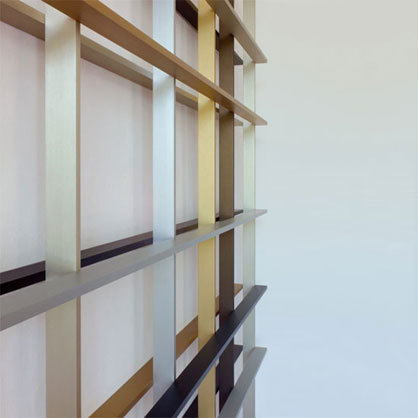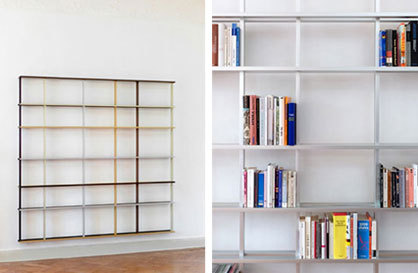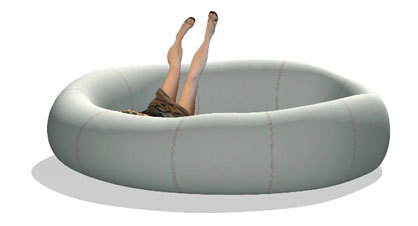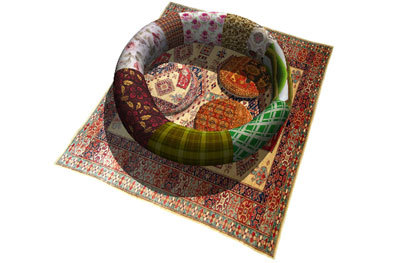"It's all about the performance"
Texto por Nora Schmidt
Berlin, Alemania
23.09.09
As with many other architects the design is being strongly influenced. You literally speak of architects' design.
Tom, you have created architecture for a long time. In what way does this influence your work as a designer?
As with many other architects the design is being strongly influenced. You literally speak of architects' design. So you just feel if an object was created by a trained industrial designer or rather by an architect. Because an architect is used to thinking in bigger dimensions, he doesn't give that much attention to detail and the form of an object. He has a rather skeptical approach to design and tries to integrate other parameters. A designer doesn't fundamentally question the function, but tries to revive it with a bold form. The architect is obsessed with philosophic thoughts about behaviours, spaces for movement and everyday functionality, obviously with various degrees of success.
And that has to do with the dimensions?
Of course. The architect is a general planner and the bigger the matter he is planning, the more conscious he becomes about the processes involved. He has to consider time, space and approaches. He always has to bare the parameters which can influence the procedure in mind. All of this together has a higher complexity. This leads to solutions which indeed express themselves in a certain style, but point out to the actual application stronger. And exactly that is what my objects shall do.
Your dwelling objects move away from the established prospect. Doing this, you seem to be inventing completely new types of furniture as for example the "Wohnwagen". What exactly is your goal creating those dwelling objects? And what is your approach to this?
It's all about performance. You could say, I see the use the object highly stylised. We are actually not aware of the meaning of handling as well as the meaning of an objects independent existence. The rituals of Zen Buddhism clarify this fact. A good example is the art of archery. What is the point there? The point is to empathise the course of movement and to bring it to perfection step by step. Thereby you gain consciousness of the extensive interaction between your own body and the bow. Only such consciousness allows a deeper relationship to items: you start to appreciate them, you develop feelings. With my objects I want to implement such association with things.
Can you explain this process of conditioning on the basis of one of your objects?
I have developed a light which you carry like a flag or a torch. The illuminant soars above your head as a trophy. It demonstrates solemn might and emblematises the power over light like a torch. In contrast to this, the light has the weakness to fall over when not supported by a wall. The lance-like rod suggests further power blended with slick elegance - the one of a weapon - also resembling the handling of a stick. You will find various associations. The more there are, the more emotional the response towards the object will be.
Today, many designers achieve this attachment with ornaments and opulence. Minimalism seems to have disappeared.
Ever since minimalism has become a style, it is getting worn out through senseless application. People then start to turn towards a new style. That's why we allowed ourselves the freedom to turn back to opulence and diversity during the last couple of years, and I think that playing with mass is a good tool in order to trigger emotions. We can lose ourselves in the musical depth of a 100-strong orchestra as well as in a labyrinth-like, glutted souq in Northern Africa. Those Brazilian brothers, what was their name again...
...Humberto and Fernando Campana...
...exactly, they work with the overabundance and thereby might even question it again.
But this is only one of many possibilities. Looking at conventional objects, I always wonder what makes them so significant and how I can add this significance to the objects I create. A nice example for this is the sailing ship. It is always also a symbolic shape. The hull is substance, base and on top we have the instruments, the sails, the lightness. We can put a lot of emotionality and hope into such a ship, even though it is a purely pragmatic object. A ship really is only pragmatic. There is almost nothing that exceeds function. And still there is a lot of poetry to discover. Still we regard the shapes as complete. The notion of beauty lies simply in the used, lived and undergone objects.
So with your objects, you want to change our position to the objects which surround us, increase the appreciation of things. But when I have a look around, I see a mass of products which want to be bought and of course thrown away again as soon as possible. How can you achieve that people buy products which they want to identify themselves with and which they simply want to keep?
There have never been as many products as there are right now, and the number of them is increasing day by day. This makes it increasingly harder to bring up appreciation for the individual item. This is probably irreversible. On the other hand we still want to be enchanted. As never before, this is happening in many different areas. I believe that whilst becoming more uniform, we will form our tastes more and more individually by experiencing the ever widening mass of goods, such as TV, cinema, arts or music. Durability will then depend on the price you have to pay for something. In my opinion, it's not predictable what will, apart from that, rise and then endure due to nostalgia.
In the last couple of years there has been a noticeable approximation between art and design. Your products are functional and indeed suitable for serial production, do they still belong into galleries?
My objects are probably too subtle to be wanted by the crowd. Maximisation, breaking and strange composition trigger a desire, but the actual use rather irritates. Art, which is separated from everyday life, more and more refers to it like a mirror. On the other hand, design, which has its roots in everyday life, likes to move towards the area of art. In the best case objects with a preferably long chain of associations and good usability arise. This would be a felicitous culture of everyday life. I regard design as a mediator in order to transfer the cultural space into the space of art. This is what I demand from my work.
So also art inspires you?
Yes, let's look at Thorsten Brinkmann. He builds objects from commodity items. For example, he puts a vase onto his head, wears a stovepipe over his arm and appears as a medieval knight. He transfers items into a different context and thereby makes them conscious. Suddenly you regard the vase as a subject inside the object. You deal with it as if you were in a relationship. Who is it, that vase? What is its intent? I find his work gorgeous.











